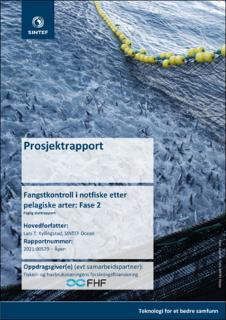Fangstkontroll i notfiske etter pelagiske arter: Fase 2 – Faglig sluttrapport
Research report
Published version
Permanent lenke
https://hdl.handle.net/11250/2785933Utgivelsesdato
2021Metadata
Vis full innførselSamlinger
- Miscellaneous publications [44]
- Publikasjoner fra CRIStin [3056]
Sammendrag
Prosjektet har hatt som hovedmål å bedre fangstkontroll i ringnotfiske gjennom å forske på instrumenter og analysemetoder som gir bedre grunnlag for beslutninger under fangstprosessen. Vi har utviklet: et beslutningsstøttesystem som gir skipper råd om navigering av fartøy og posisjonering av ringnot i forhold til fiskestim før kast; metoder som bidrar til mer effektiv akustisk fangstovervåking; metoder for å bestemme art, størrelse og atferd av fisk i kommersielt ringnotfiske; indikatorer for stress og potensiell overlevelse i kommersielt ringnotfiske for å bidra til å definere grenseverdier for slipp av uønsket fangst. The project’s main objective has been to improve catch control in purse seine fisheries by researching and developing instruments and methods which provide a stronger foundation for decisions during the catch process. We have developed: a decision support system which advises the skipper on how to navigate the vessel and position the purse seine relative to a fish school prior to casting the net; methods which contribute to improved acoustic catch monitoring; methods for describing the species, size and behaviour of fish schools in commercial purse seining; and indicators for stress and survival potential in commercial purse seining to inform on safe limits for slipping unwanted catches. The results are expected to benefit the fishing fleet in several ways, including: improved utilisation of available data on-board to understand the interplay between vessel, fishing gear and environment during the catch process; catch and gear monitoring instruments which can provide better control of the capture process and more information about the catch; more precise biomass estimates by taking fish school behaviour into account; improved fish welfare and quality due to improved control of catch and fishing gear; a prototype stereo camera system which can identify and measure the average length of fish before and during early capture; documented effects of catch-related stressors on the vitality and survival potential of the catch, as well as the quality of the retained catch; and improved understanding of how slipping procedures affect the survival potential of slipped catch.
